
The Solar-Terrestrial Centre of Excellence (STCE) is a collaborative network of the Belgian Institute for Space Aeronomy, the Royal Observatory of Belgium and the Royal Meteorological Institute of Belgium.
 |
Published by the STCE - this issue : 6 Feb 2015. The Solar-Terrestrial Centre of Excellence (STCE) is a collaborative network of the Belgian Institute for Space Aeronomy, the Royal Observatory of Belgium and the Royal Meteorological Institute of Belgium. |
| Archive of the newsletters | Subscribe to this newsletter by mail |
During the noon hours of 30 January 2015, a coronal jet was visible near the Sun's east limb. Coronal jets are rather narrow ("squeezed") ejections of solar plasma that result from magnetic reconnection between some emerging flux and pre-existing "open" field structures. The reconnection results in jets that emit material up into the higher solar atmosphere and even into space if the eruption is strong enough. The precise mechanism(s) behind the acceleration and squeezing of the jet are not known yet in full detail. A movie of the event can be seen at http://youtu.be/dbrTM25ke_I
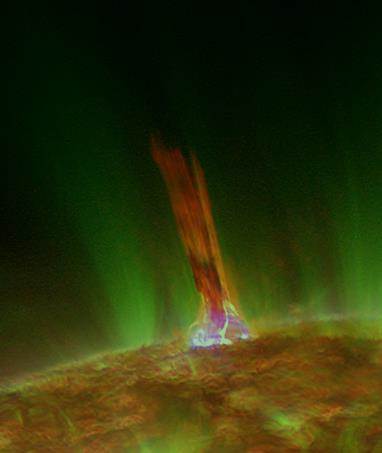
The 30 January jet was visible in EUV from about 12:55 till 14:00UT. It did not leave an obvious x-ray signature, the x-ray flux being mostly influenced by the solar flare activity from active regions NOAA 2268 and 2277. Indeed, the latter produced a short-duration M2 flare peaking at 12:16UT, while the enhanced flux around 12:56UT was produced by activity in NOAA 2268. The slow x-ray evolution of the latter event was not even classified as a flare.
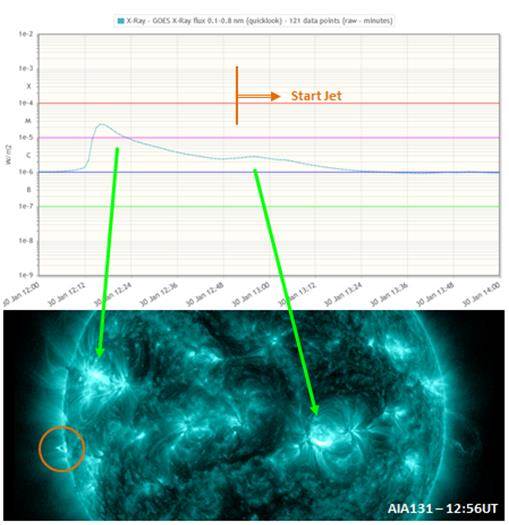
The jet consisted of relatively "cool" material. This can be seen in the comparison images underneath, where the jet becomes "darker" and less visible as the temperature in which the EUV filter observes, increases. The jet was also visible in H-alpha, a filter providing views of the lower solar atmosphere at even lower temperatures (about 10.000 degrees).
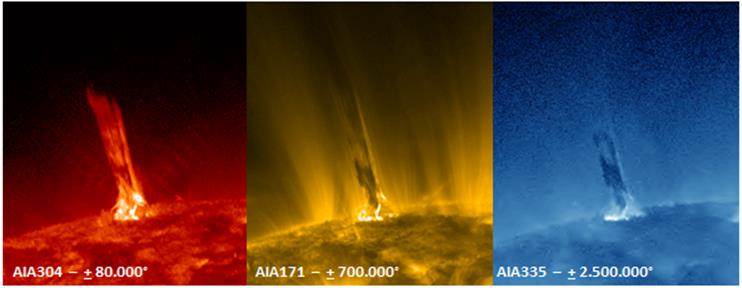
What seems to have happened in this case is that a small filament became unstable and, while erupting, got in contact with the "leg" of a low-lying coronal loop. There, the reconnection took place and the material was ejected along the open field lines into space. The point of reconnection and the jet itself seem to be somewhat off-set, hence the name lambda jet (the more symmetrical case is called "Eiffel tower jet"). With some imagination, the greek letter can indeed be seen in the loops and jet. Some further analysis may be required to have a final answer (line-of-sight effects,...). The imagery underneath is a composition of EUV images from AIA 304, 171 and 094 filters.
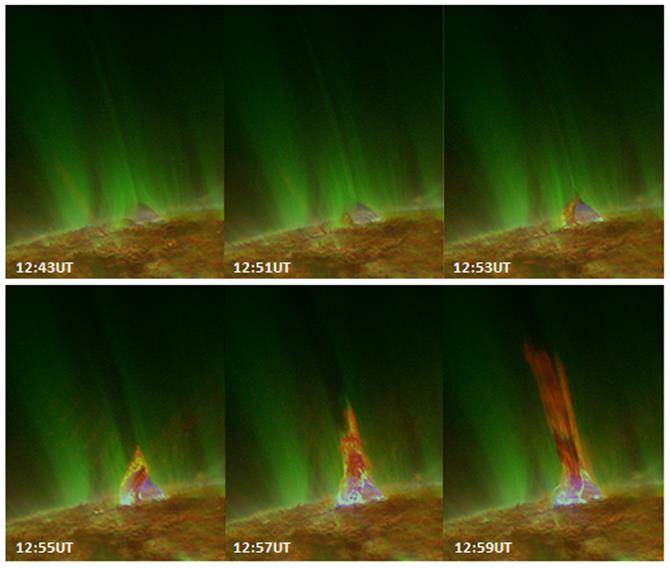
A rudimentary evaluation of the AIA304 imagery seems to indicate that the speed of the jet was about 280-410 km/s. This is quite typical for this kind of jets, and it is high enough to allow part of the ejected material to escape into space. This can be seen in images from SOHO's coronagraphs, though the jet quickly becomes diffuse and difficult to trace, which also hampers accurate speed measurements. The rest of the material can be seen falling back along the magnetic field lines towards the solar surface (EUV imagery).
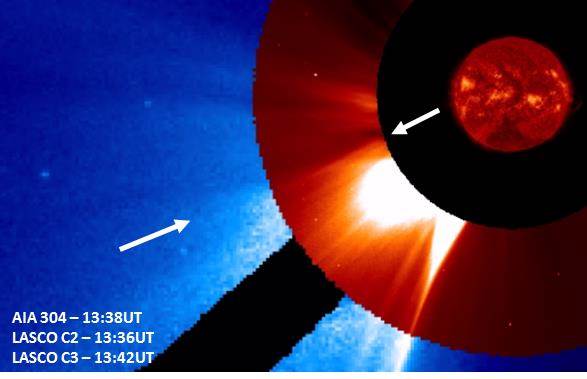
Credits - Data and imagery for the movie clips were taken from SDO (http://sdo.gsfc.nasa.gov/data/aiahmi/), SOHO (http://sohowww.nascom.nasa.gov/), STAFF (http://www.staff.oma.be/), and (J)Helioviewer (http://helioviewer.org/).
Solar flare activity fluctuated between low and moderate during the week.
In order to view the activity of this week in more detail, we suggest to go to the following website from which all the daily (normal and difference) movies can be accessed:
http://proba2.oma.be/ssa
This page also lists the recorded flaring events.
A weekly overview movie can be found here: http://proba2.sidc.be/swap/data/mpg/movies/weekly_movies/weekly_movie_2015_01_26.mp4
(SWAP week 253).
Below we provide a SWAP image showing the well observed M1.4 flare that occurred on 2015-01-28 at the centre of the disk. We also provide a link to the daily movie of that day, to highlight an eruptive event occurring at the East limb at the same time as the M1.0 flare.
The daily movie of 2015-01-30 shows the three M-class flares observed by SWAP that day.
M1.4 flare peaking around 04h41 (S10E08)
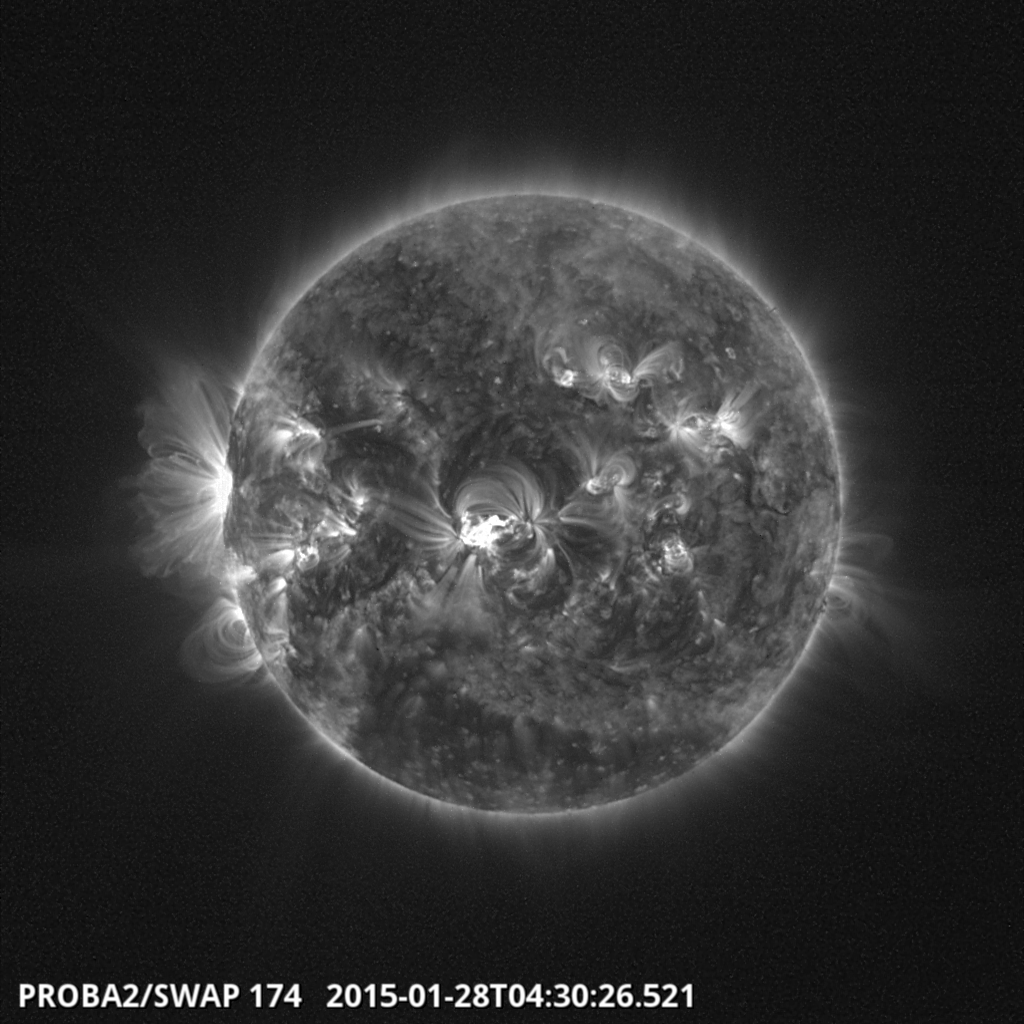
M2.0 flare peaking around 00h44 (S13W16)
M1.7 flare peaking around 05h36 (S12W19)
M2.4 flare peaking around 12h16 (N07E52)
See SWAP daily movie of 2015-01-30: http://proba2.sidc.be/swap/data/mpg/movies/20150130_swap_movie.mp4
A total of 48 C- and 7 M-class flares were recorded over the period, with solar activity dominated by active regions NOAA 2268 and 2277. These sunspot groups were responsible for the majority of the C-class flares and produced resp. 5 and 2 M-class flares. NOAA 2277 was also the source of the strongest flare of the week: an M2.4 peaking on 30 January at 12:16UT. Both groups started to simplify after this event, and no further M-class flares were observed.
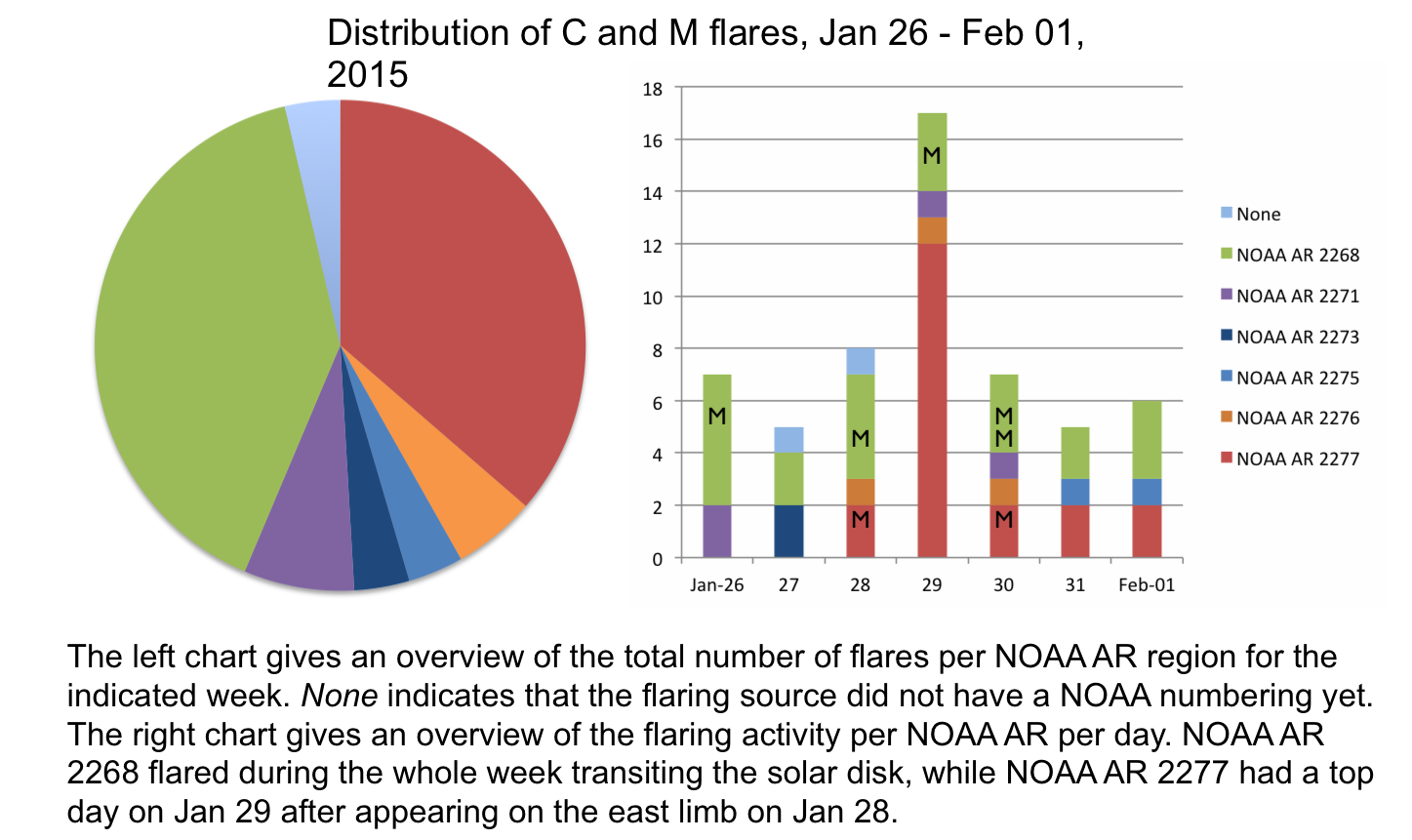
In response to the M-class activity, the greater than 10 MeV proton flux was enhanced from mid 28 till late on 31 January. With a maximum of 1.5 pfu at 12:05UT on 30 January, the flux stayed well below the proton event threshold (10 pfu) as can be seen in the graph below. No Earth-directed CMEs were observed.
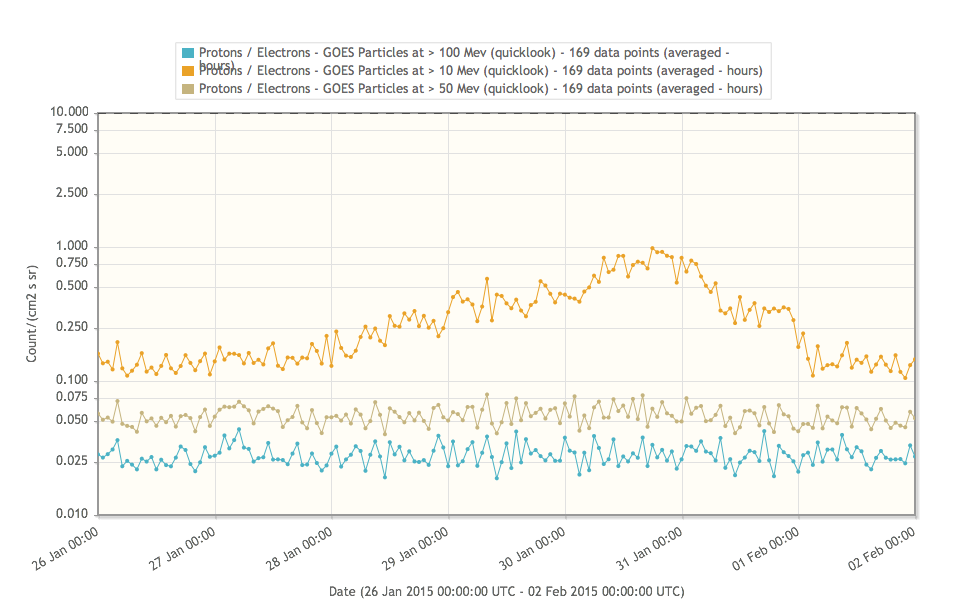
| DAY | BEGIN | MAX | END | LOC | XRAY | OP | 10CM | TYPE | Cat | NOAA |
| 26 | 1646 | 1653 | 1658 | M1.1 | 2268 | |||||
| 28 | 0421 | 0441 | 0455 | S9E9 | M1.4 | 2N | CTM/1III/1 | 2268 | ||
| 28 | 2132 | 2137 | 2140 | N8E73 | M1.0 | SF | 2277 | |||
| 29 | 1132 | 1142 | 1152 | S12W6 | M2.1 | 1B | 73 | 2268 | ||
| 30 | 0032 | 0044 | 0102 | M2.0 | III/1 | 74 | 2268 | |||
| 30 | 0529 | 0536 | 0635 | M1.7 | CTM/1 | 74 | 2268 | |||
| 30 | 1210 | 1216 | 1221 | M2.4 | 10 | I/1 | 78 | 2277 |
| LOC: approximate heliographic location | TYPE: radio burst type |
| XRAY: X-ray flare class | Cat: Catania sunspot group number |
| OP: optical flare class | NOAA: NOAA active region number |
| 10CM: peak 10 cm radio flux |
The geomagnetic field was under the influence of the high speed streams (HSS) from two coronal holes (CH). The first HSS arrived on 26 January and was preceded by a corotating interaction region (CIR). The CH indicated with the red circle in the image below is likely the source. It reached a maximum speed of about 530 km/s and resulted in active conditions on 26 January and locally (Dourbes) again early on 28 January.
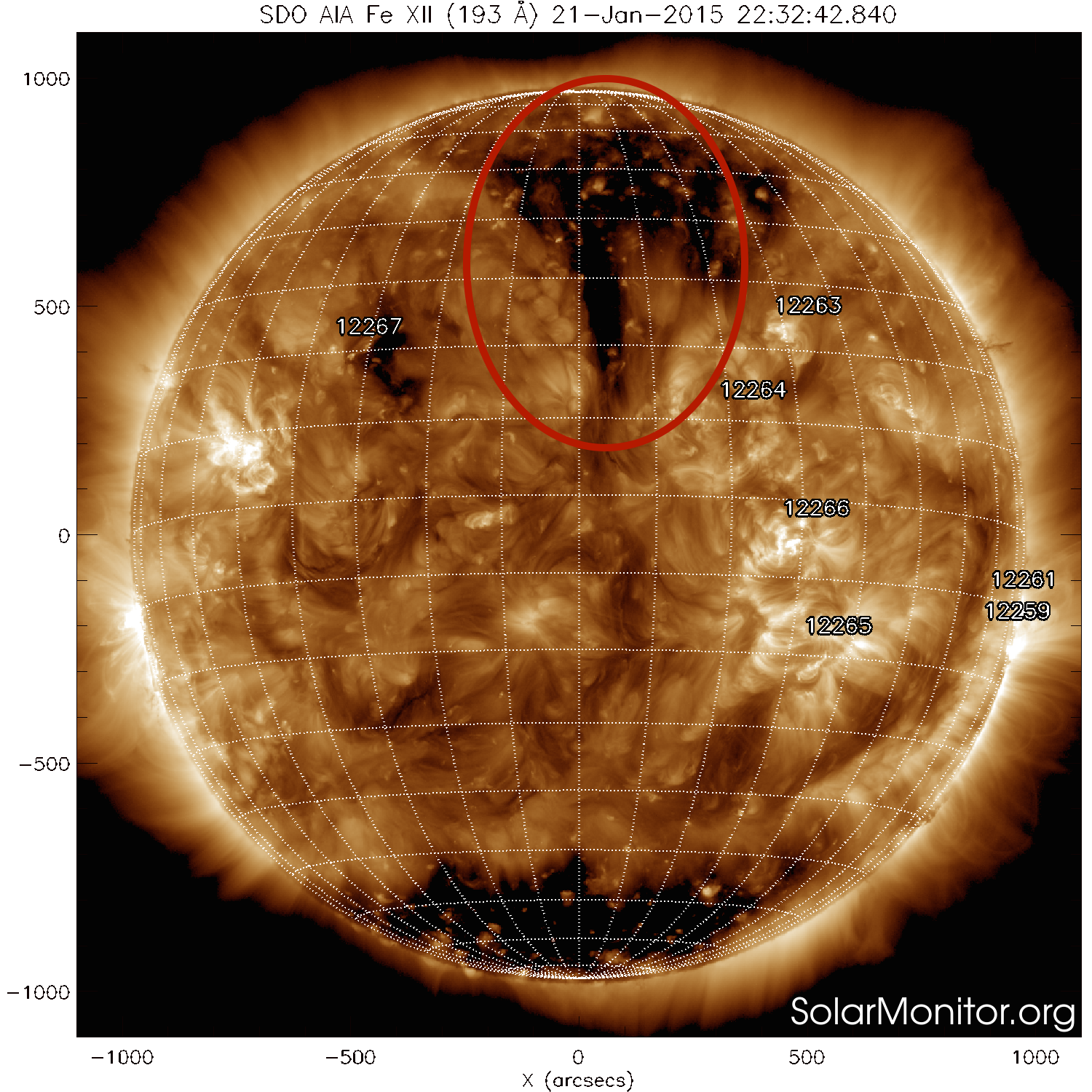
The second HSS arrived late on 31 January and was related to the extension of a southern polar coronal hole. The solar wind associated with this hole had a speed up to around 700 km/s.
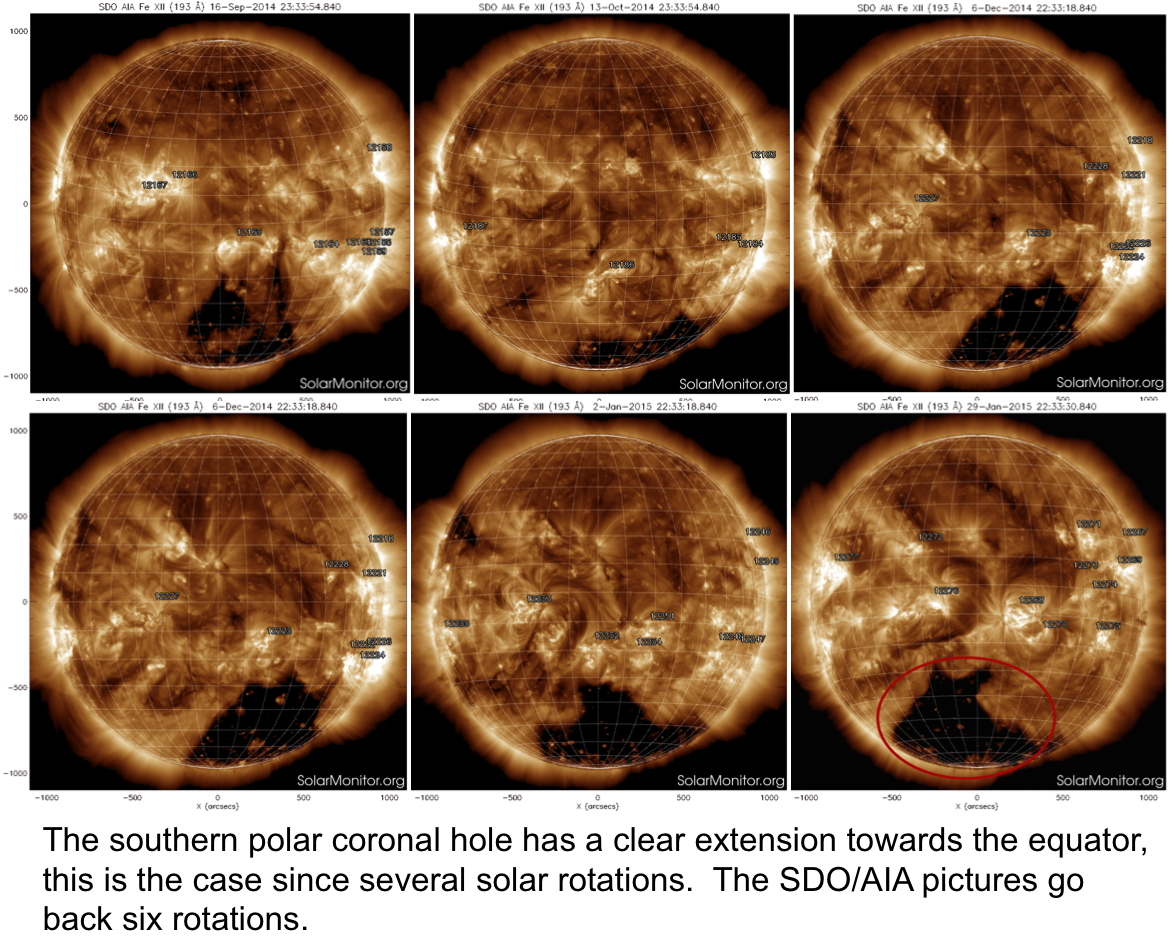
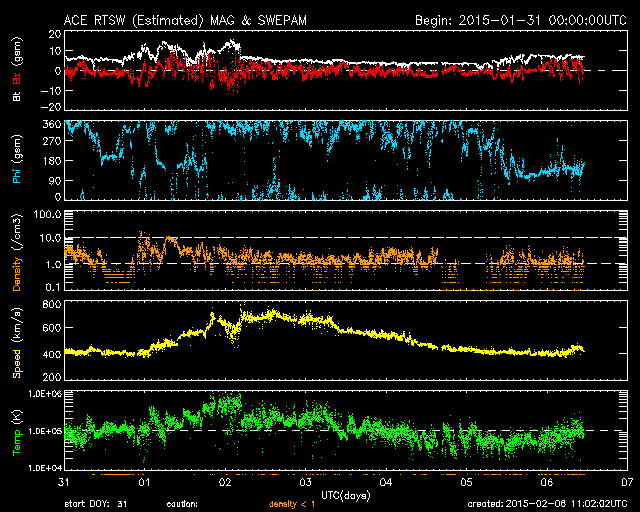
A full view on all the solar wind parameters of the period the southern polar CH influenced the earth is given by the satellite ACE, with the CIR followed by a gentle increase in solar wind speed. It resulted in active conditions around midnight on 01 February, and minor geomagnetic storming late on 01 and early on 02 February. Active conditions were also observed late on 29 January (minor storm at Dourbes) and locally again late on 30 January. Both may have been the result from persistent CH HSS, though it cannot be excluded that the 29 January disturbance originated from a glancing blow of a slow CME observed on 24 January.
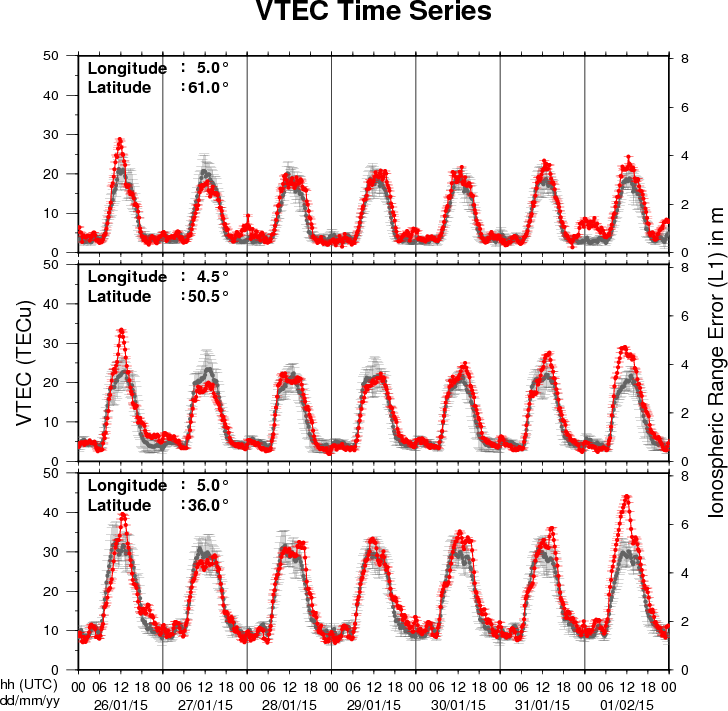
The figure shows the time evolution of the Vertical Total Electron Content (VTEC) (in red) during the last week at three locations:
a) in the northern part of Europe(N61°, 5°E)
b) above Brussels(N50.5°, 4.5°E)
c) in the southern part of Europe(N36°, 5°E)
This figure also shows (in grey) the normal ionospheric behaviour expected based on the median VTEC from the 15 previous days.
The VTEC is expressed in TECu (with TECu=10^16 electrons per square meter) and is directly related to the signal propagation delay due to the ionosphere (in figure: delay on GPS L1 frequency).
The Sun's radiation ionizes the Earth's upper atmosphere, the ionosphere, located from about 60km to 1000km above the Earth's surface.The ionization process in the ionosphere produces ions and free electrons. These electrons perturb the propagation of the GNSS (Global Navigation Satellite System) signals by inducing a so-called ionospheric delay.
See http://stce.be/newsletter/GNSS_final.pdf for some more explanations ; for detailed information, see http://gnss.be/ionosphere_tutorial.php
Start : 2015-03-16 - End : 2015-03-19
This international conference will provide an overview of our
current understanding of Sun-Climate Connections starting at
processes on the Sun itself over space weather and solar wind
towards solar influence on the upper atmosphere down to the ocean.
It will also provide insights into the heatedly debated role of the
Sun in climate change. In four sessions the various contributions
of solar variability influence on Earth's climate will be presented
and discussed by bringing together solar physicists, space
scientists, atmospheric scientists, climate modellers, and
paleoclimatologists.
We expect contributions from scientists participating in
SCOSTEP/ROSMIC, SPARC-SOLARIS/HEPPA, the EU cost network TOSCA, as
well as any other interested scientists. The conference will last
three full days, beginning Monday morning, 16 March 2013. The
programme will consist of invited and keynote lectures, a few
contributed oral presentations and ample time dedicated to poster
sessions. The fourth day will be devoted to public outreach
activities as well as panel discussions.
Website: http://scc.geomar.de/
Start : 2015-05-18 - End : 2015-05-22
URSI AT-RASC 2015 will be the first edition of the newly
established triennial URSI Atlantic Radio Science Conference as one
of the URSI Flagship Conferences. AT-RASC 2015 will have an open
scientific program composed of submitted papers within the domains
covered by all ten Commissions of URSI.
Website: http://www.at-rasc.com/
Start : 2015-06-01 - End : 2015-07-24
The Space Weather Summer School at Los Alamos National
Laboratory, established in 2011 under the founding Director Josef
Koller, is dedicated to space weather, space science and
applications. Every year we solicit applications for the Los Alamos
Space Weather Summer School. This summer school is sponsored and
supported by a number or organizations at LANL. This year our top
sponsors include the Los Alamos Institute of Geophysics, Planetary
Physics and Signatures (IGPPS) and the Laboratory Directed Research
and Development Office (LDRD). The summer school brings together
top space science students with internationally recognized
researchers at LANL in an educational and collaborative
atmosphere.
Website:
http://www.swx-school.lanl.gov/
Start : 2015-07-21 - End : 2015-07-23
The conference will review past and recent achievements, as well
as future challenges in the field of solar coronal loop
physics.
Website:
http://www.damtp.cam.ac.uk/user/astro/cl7/index.html
Start : 2015-07-28 - End : 2015-08-04
Heliophysics is all of the science common to the field of the
Sun-Earth connections. This fast-developing field of research
covers many traditional sub-disciplines of space physics,
astrophysics, and climate studies. The NASA Living with a Star
program, with its focus on the basic science underlying all aspects
of space weather, acts as a catalyst to bring the many research
disciplines together to deepen our understanding of the system of
systems formed by the Sun-Earth connection.
Website:
http://www.heliophysics.ucar.edu/
Start : 2015-07-30 - End : 2015-08-06
The 34th International Cosmic Ray Conference (ICRC) will be held
from July 30 to August 6, 2015, in The Hague, The Netherlands. It
is an important and large conference in the field of Astroparticle
Physics. The ICRC covers: cosmic-ray physics, solar and
heliospheric physics, gamma-ray astronomy, neutrino astronomy, and
dark matter physics.
Website: http://icrc2015.nl
Start : 2015-10-05 - End : 2015-10-09
This CSPM-2015 scientific meeting will cover various aspects of
solar dynamic and magnetic phenomena which are observed over the
entire electromagnetic spectrum: white-light, Hα, Ca II,
and radio from ground and in a variety of other wavelengths (white
light, UV and EUV, and X-rays) from space. Emphasis will also be
placed on instrumentation, observing techniques, and solar image
processing techniques, as well as theory and modelling through
detailed radiative transfer in increasingly realistic MHD models.
The long-term (cyclic) evolution of solar magnetism and its
consequence for the solar atmosphere, eruptive phenomena, solar
irradiation variations, and space weather, will be in focus. Here,
special attention will be devoted to the long-term observations
made in Coimbra and also to the results of the SPRING / SOLARNET
and SCOSTEP VarSITI studies. In particular, the weak solar activity
during the current solar maximum will be discussed. Finally, since
this meeting is organised around the 90th anniversary of performing
the first spectroheliographic observations in Coimbra, a session
will be specially dedicated to new solar instruments (both
ground-based and space-borne) that will give access to unexplored
solar atmospheric features and dynamic phenomena over the coming
years.
Website:
http://www.mat.uc.pt/~cspm2015/
Start : 2016-07-30 - End : 2016-08-07
The 41st COSPAR Scientific Assembly will be held in Istanbul,
Turkey from 30 July - 7 August 2016. This Assembly is open to all
bona fide scientists.
Website:
https://www.cospar-assembly.org/